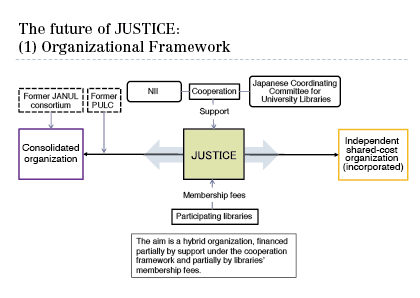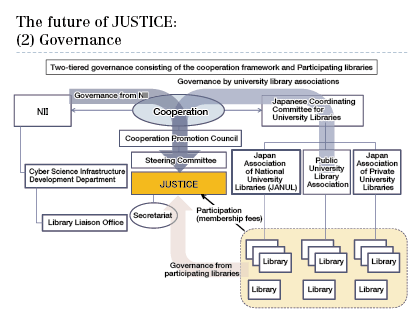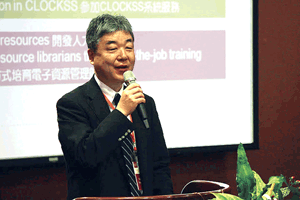Makoto Nakamoto
(Waseda University Library)
● Introduction: On the Creation of the Japan Alliance of University Library Consortia for E-Resources (JUSTICE)
In October 2010, the National Institute of Informatics (NII) and the Japanese Coordinating Committee for University Libraries signed an agreement intended to “further strengthen the acquisition and dissemination of the scholarly information that is essential to Japan’s universities and other academic and research institutions, as scholarly communications rapidly become increasingly digitized.” The main areas of cooperation foreseen were:
• acquiring and ensuring perpetual access to e-journals and related materials, including back files
• building systems based on institutional repositories for the dissemination of knowledge held by universities
• strengthening union catalog databases, including those for e-resources
• personnel exchanges, training, and international cooperation
The agreement called for the two parties to set up a “Cooperation Promotion Council” to further their joint efforts in these areas. At its first meeting, in January 2011, the Council addressed the pressing issue of consolidating library consortia in order to secure the stable supply of e-journals, and decided to establish a Steering Committee for that purpose consisting of working-level librarians from NII, the Japan Association of National University Libraries (JANUL), and the Private and Public University Libraries Consortium (PULC). It was decided that the consolidated organization would be named the “Japan Alliance of University Library Consortia for E-Resources” (JUSTICE), and that it would have a secretariat in the form of a Library Liaison Office to be newly established in FY 2011 within NII’s Cyber Science Infrastructure Development Department. On March 25 the first step toward integrating JANUL and PULC was taken when a preparatory meeting of the Steering Committee formulated basic guidelines for JUSTICE’s initial phase of operations.


The most obvious benefit of the alliance is greater economies of scale in negotiating with publishers. JANUL and PULC have a combined total of nearly 500 member libraries, making this one of the world’s largest university library consortia for e-resources. A further benefit is the closer involvement of NII, which has long supported university library services in Japan at the infrastructure level, and whose participation in the alliance’s governance should ensure the stable provision of a consolidated e-journal infrastructure with few parallels in the world. It is also worth noting that the secretariat long desired at the working level among the consortia has been realized under the framework of coordination with NII. We need to make concerted efforts that go beyond short-term license arrangements to build a stable, self-sustaining infrastructure, and the creation of the Library Liaison Office as the nucleus of future cooperation is a decisive step in this direction.
This new alliance, with its own secretariat, is unfamiliar territory for Japan’s university libraries. There are likely to be many difficulties ahead for an organization which involves not only cooperation among different types of university (national, non-national public, and private) but also coordination with NII. If it is to operate on a stable basis, JUSTICE will need governance that guarantees transparency toward the entire university library community, and securing the financial resources to operate the new alliance is another important task. The member libraries should perhaps pool their expertise in a new kind of governance; in that regard, it remains to be seen whether the alliance should aim to operate autonomously.
● The Meaning and Importance of Cooperation
Consortia entered the spotlight in the 1990s, when libraries faced the “serials crisis.” Seeking economies of scale by joining together to negotiate directly with publishers, the libraries began to pool their funding to purchase bundles of journal subscriptions. The resulting consortia could be one response of the library community to the serials crisis, and it was perhaps inevitable that the consortia should then increasingly cooperate among themselves in order to gain further economies of scale in negotiations.
JANUL and PULC have been in existence for almost a decade, and examples of such cooperation during that time, achieved together with NII, include their joint introduction of the SpringerLink Online Journal Archive (2005) and the Oxford Journal Archive (2006) to provide systematic access to e-journal back files, and of the 19C/20C House of Commons Parliamentary Papers (2008) and the Making of the Modern World digital collection (2010) in order to build an infrastructure of databases in the humanities and social sciences, which have been rapidly improving in recent years. Similarly, in 2010, they combined forces to join CLOCKSS, an international joint venture to build a dark archive. Also, JANUL and PULC have jointly negotiated annual licensing agreements with the American Chemical Society, and JMLA/JPLA and PULC have done the same with Science; thus, these consortia have been steadily expanding the framework of their negotiations with publishers.
These cooperative efforts among university libraries have restored their standing as centers of scholarly communication, which the serials crisis had begun to undermine. Indeed, where scholars under the old print-based paradigm had to depend on the subscriptions and purchases of their own institution’s library, they now have instant access to all the digital information they want, and by the same token the channels for disseminating their research findings have expanded enormously. In terms of price models, however, the terms dictated by publishers generally require customers to maintain their current spend on that publisher’s print titles, and the fact is that prices are still on the rise. Yet, for the universities, because these days networked scholarly communication is virtually a precondition to fulfilling their mission of research and education, the necessary access environment and information infrastructure have essentially become their lifeline.
Today the scope of negotiations with publishers goes beyond price models and other license arrangements to impact scholarly communication at a more intrinsic level, affecting how information is distributed and utilized and who bears the associated costs. Since the print-to-digital shift in publishing models, these negotiations are further complicated by questions of how best to reflect new added-value services and their costs in the price model—issues that were not even conceivable in the print era.
The situation regarding the optimal price model for journals in a digital environment remains opaque, but if the current price rises continue unabated, it is not difficult to imagine that the market will eventually collapse.
Conditions have been changing in another major way for university libraries: let us not forget that their management continues to be significantly affected by the competitive environment introduced to Japan’s institutions of higher education by policymakers since the 1990s. Forced to adapt, universities are, almost without exception, looking to expand into new fields and to reduce their operating budgets, and library expenses, including acquisitions, have become the target of cuts at quite a number of universities.
As university librarians, our strategy for the foreseeable future must be to cooperate more closely through consortia and the like as we negotiate with publishers, in order to curb price rises to some extent, while at the same time attempting to find the optimal sustainable price model.
● The Value of Cooperation: Accountability and Assessment
Libraries have traditionally built cooperative ties horizontally among themselves in order to expand their services and make them more efficient. In a sense, they have tried to achieve their mission by providing centralized, cross-organizational services. The value of this cooperation should be measured in terms of the value that each participating institution realizes or its contribution to achieving the mission. In the present climate the value of university libraries themselves can no longer be taken for granted, but it is difficult to prove other than by demonstrating how the library advances the missions of the parent university.1 In assessing frameworks of cooperation, on the other hand, we must broadly assume that the participating institutions share common basic values.
According to a recent overview of the activities of 45 major library consortia in the United States,2 they have the following missions in common:
• resource sharing networks (union catalog)
• reciprocal borrowing
• institutional repositories
• digital collections
• database licensing
• cooperative collection building
• courier services
The report notes: “Most mission statements emphasized the consortium’s purpose in optimizing access to resources in a way that … minimizes costs and reduces duplication.”

The author at the OCLC Asia Pacific Regional Council 3rd Membership Conference, National Taiwan University, Taipei, October 17-18, 2011
According to the report, American library consortia generally aim to self-finance through membership fees, but a debate over the value of membership has emerged, especially in the 2000s. The main issue is whether the benefits of cooperation are commensurate with the costs (membership fees); the benefits have been examined from various viewpoints, such as savings or reductions in operating costs, especially resource budgets, for the individual member libraries. The discussion has also extended to the use of management metrics such as Cost-Benefit Analysis (CBA) and Return on Investment Analysis (ROI), which are common tools in the business and marketing fields. Behind this debate are changes in the higher education environment in the US, similar to the intensifying competition seen in Japan since the 1990s. Over the past two decades, under conditions of protracted economic slowdown or recession, the value of institutions of higher education has begun to be questioned on many levels, and, coupled with the introduction of pro-competition policies, this has led stakeholders to demand that their institutions be accountable. Naturally, academic libraries, as branches of institutions of higher learning, are also being held accountable, but while assessment using quantitative management metrics is certainly an important element of accountability, that is merely one aspect of the value that a library should realize. In thinking about academic libraries’ achievement of value or of their mission, we may need to think again about how library consortia, as a cooperation framework, can be made accountable to their wide range of stakeholders.
● Toward a New Cooperation: Across the Barriers of Institutional Type
Universities are made up of faculty, who are both researchers and educators; students, who are budding researchers and users of educational services; and administrative staff, who support the institution’s work at the infrastructure level. All of Japan’s universities, whether national, non-national public, or private, carry on their educational and research activities while receiving financing to a greater or lesser extent from the government and other public institutions in support of policy goals.
Until now, university libraries have basically cooperated under three separate groupings: the Japan Association of National University Libraries (JANUL), the Public University Library Association, and the Japan Association of Private University Libraries, while the Japanese Coordinating Committee for University Libraries provided loose coordination among the three groups. Almost a decade after its emergence, the new cooperative structure prompted by the serials crisis and the advent of e-journals has transcended this old framework. Now, as JUSTICE embarks on its new venture with a new partner, NII, needless to say the criterion of value that its members should hold in common and realize must contribute to the public mission to be realized by all the member libraries and their parent universities. It has long been said that the academic library is the “heart of the university.” I believe we can expect much of this new framework of cooperation, JUSTICE, to help ensure that the library continues to be the heart of the university in the future. I hope JUSTICE will receive your further understanding and support and the active participation of more university libraries.
References
| 1. |
Oakleaf, M. The value of academic libraries: A comprehensive research review and report. Chicago: Association of College and Research Libraries. 2010. www.ala.org/ala/mgrps/divs/acrl/issues/value/val_report.pdf |
| 2. |
Chadwell, FA. “Assessing the value of academic library consortia.” Journal of Library Administration. vol. 51, no. 7-8, 2011, p. 645-661. |
|

